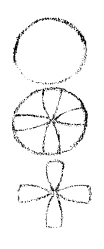Discussions with Teachers
GA 295
Discussion Three
24 August 1919, Stuttgart
Translated by Helen Fox
Someone told the story of “Mary’s Child,” first for melancholic and then for sanguine children.
RUDOLF STEINER: I think in the future you will have to pay more attention to your articulation. The two versions, as you gave them, were too much alike. The difference must also lie in the articulation. If you bring out these details more emphatically you will not fail to impress the melancholic children. For the sanguines I would introduce more pauses into the story, especially at the beginning, so that the children are compelled to listen to you again each time their attention wanders. But now I would like to ask how you would apply these stories when you are actually teaching? Imagine yourselves standing in front of the class; what would you do? I would advise you to tell the story in the melancholic version and then have it retold by a sanguine child and vice versa.
A person comments: First, I think it would be advisable to seat the sanguine children directly in front of the teacher so they may be constantly within view, whereas melancholic children should be sitting where they like as much as possible.
RUDOLF STEINER: An excellent suggestion.
The individual who commented then related the story of “The Long-tailed Monkey,” first in a style for the sanguine and then for the melancholic children, adding the remark that melancholic children do not want to hear too many sad stories.
RUDOLF STEINER: You should also remember that, but the contrasting styles were good. Now I think we can go on to how we should make further use of these things later. I would not decide which child is to tell the story, but after a day or two I would say (in a lively way): “Now listen! You can choose for yourselves which part of the story you would like to retell. Then the next day or the day after that any child who wants to can come out and tell a portion of the story to the class.
Someone else told another story in two versions.
RUDOLF STEINER: You all have the feeling, don’t you, that something like this can be done in various ways. Now it is really very important, particularly for those who want to work as teachers, to get rid of the habit of unnecessary criticism. As a teacher you should develop a strong feeling for this; you should definitely be conscious that it is not a question of always trying to improve on what has already been done. A thing can be good in a variety of ways. And so I think it will be good to view what has been presented as something that can certainly be done as you have proposed.
But there is one thing I would like to add. In all three stories I think I noticed that the first rendering, both in style and purpose, was the better of the two. Which did you work out first in your mind, Miss A? Which did you feel you could do better? [It was determined that the version worked out first was for the melancholic temperament, and this was the better of the two]. I would now like to recommend that all three of you work out a version for the phlegmatic child. This version is very important from the perspective of style. But if possible please try to work this out tentatively today, then sleep on it and come to your final decision about the style tomorrow. It has been found by experience that when you have something like this to do, you can only discover its new form in a different spirit when, after the preparation, you allow it to pass through a period of sleep. On Monday bring us a version for the phlegmatics, but prepare it first and then later work out its final form. Having the Sunday in between will make this possible.
Someone showed a drawing, a design in blue and yellow for a melancholic child. Dr. Steiner drew the same design in green and red for a sanguine child.
RUDOLF STEINER: Now you can say to the children: This blue and yellow one can be seen best when it is getting dark; you take it into sleep with you, because that is the color with which you can appear before God. This one, the green and red one, can meet your eyes when you awake. You can gaze at it when you wake up in the morning and enjoy it for the rest of the day!
A drawing for a sanguine child was then displayed, red on a white ground. Dr. Steiner drew the same design for a melancholic child, long and thin on a black ground. Dr. Steiner called the impudent form sticking out a “little kicker.”1Kickerling = indicating a small football player.
RUDOLF STEINER: In the design for the melancholics this little creature withdraws into the form. Here you see the contrast, a kind of contrast where you would primarily use the colors in order to work on one child or another, and you should certainly show the same thing twice. What would you say to the children?
I would ask them which one they liked best.
RUDOLF STEINER: You would then make your own discoveries! You would recognize the sanguine children from their joy in this contrast of colors. You should not miss the opportunity to use simple forms like these for the children.
Someone recommended forms pointed outward for the choleric:
to be changed to an enclosed form

or to be changed to:

For the phlegmatic he recommended the opposite way, to start from the circle and have figures drawn inside it or to break up a circle in some way:

RUDOLF STEINER: For the phlegmatic child I would add the following in this method. I should say:
“Look, here is a circle. You like that don’t you?
“But now I’ll draw something else for you:
“And if I simply take away the circle, then you have the form as it should be. You must get into the habit of not muddling things up together.”

By drawing things and rubbing them out again the phlegmatic child can be torn out of his phlegma. Now I will also ask you, Frau E., to work out the same design for other temperaments again, making use of the method of sleeping over what you have done.
A description of a gorilla was given in two versions.
RUDOLF STEINER: Of course nothing can be said against your inventing things without depending on any particular naturalists, although you may very well get suggestions from them. I would ask you, however, to awaken a closer contact with your students when you tell them a story of this kind. It would also be possible to use a long story and to make an impression with that. You must, however, not be absorbed in your own thoughts, but maintain closer contact with your students. If you are too absorbed in yourself you could easily lose contact with the children.
A horse was described for phlegmatic and choleric children.
RUDOLF STEINER: In giving descriptions of animals it is especially important that, in every detail, we should remain clear in our minds that a human being is really the whole animal kingdom. The animal kingdom in its entirety is humankind. You cannot, of course, present ideas of this kind to the children theoretically, and you certainly should not do so.
Let’s suppose, however, that someone has to work out in detail the subject Mr. L. introduced, and also distinguish between the phlegmatic and choleric groups. The phlegmatics are not as easily interested and they are not likely to remember much of what you tell them about an ordinary animal, such as a horse. They have seen horses often enough that they have very little interest in them.2This statement may not apply to the children of today, as it did in 1919. But it is important to focus their attention, so I should say to the phlegmatic children, “Well now, what is the real difference between you and a horse? Let’s take some minor differences. You all have a foot like this, don’t you? Here are the toes, here is the heel and here is the instep.

“Now look at a horse’s foot. This is the hind foot of a horse. Where are the toes? Where is the heel? And where is the ankle? With you the knee is farther up. Where is the knee of a horse? Now look, here are the toes, the heel is right up there and the knee farther up still. It is very different. Just imagine how different a horse’s foot looks from yours.” You will now find that this will surprise the phlegmatic child into alertness, and what you have said will not be forgotten.
For the choleric children I would tell a story about how a child meets a horse out in the woods somewhere. The horse is running; and far behind, running after it, there is a man from whom it has bolted, and the child has to catch the horse by the bridle. If I know I have a choleric child before me I can try to show how the child should do this, how to get hold of the bridle. To get the child’s fantasy working to discover how the horse should be caught is a very good thing. Even a choleric child feels a little nervous about such a procedure, but you are meeting the need of the choleric temperament when you expect the child to do it. Such a child will become a little disconcerted and less arrogant. Something is expected of the child that can only be expected of a choleric child.
I would also like to say that, especially at first, you should make all such stories very short. So I will ask Mr. M. in this case to tell his story for sanguine and melancholic children, but let both stories be exceedingly short. Mr. L., you could do the same but choose particular incidents that will be remembered and serve to arouse the children’s eager interest.
We must realize that we should use the subject matter of our teaching primarily to capture the child’s powers of will, feeling, and thought; it is not so important to us that the children remember what they are told, but that they develop their soul faculties.
Someone spoke of how to consider the four temperaments in arithmetic, but explained that he had not really managed to work this out properly.
RUDOLF STEINER: I had foreseen that, because this problem is very difficult. You will have to sleep on it very thoroughly.
But please take the following as a fresh problem. Imagine to yourself a class in which there are children of eight and nine years old. In the teaching of the future it will, of course, be important that we develop as many social instincts as possible, that we educate the social will. Now imagine three children of whom one is a pronounced phlegmatic, another a pronounced choleric, and the third a pronounced melancholic. I will say nothing about their other qualities. Let’s suppose that in the third or fourth week after school had begun these children come to you and say, “None of the other children can stand me!” Immediately it would be obvious that these are the “Cinderellas” of the class, and all the other children are inclined to avoid them. By Monday I would like you to think over how the teacher can best try to remedy this evil. Please give your whole mind to thinking this through, and view it as a very important educational problem.

